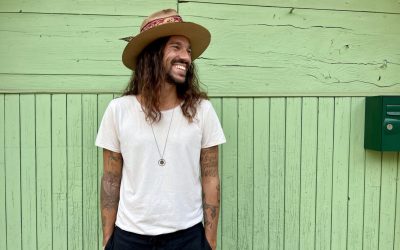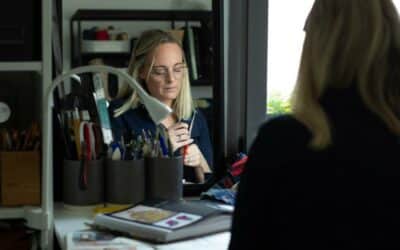Karen Maenhout
Illustrator and paper engineer
Karen Maenhout draws, and does more than that. Pencil and paper are the materials in which she gives free hand to her rich world of feelings and intuition. Karen visualises and gives shape to deeply felt emotions, both in drawings and 3D pop-ups. Karen offers drawings for people to read. In this way, each reader creates a unique story based on their feelings. Only when the drawing is read, the story is created.
Karen uses paper to engineer 3D pop-ups, after extensive mathematical calculations and trials. With her own sensitivity drawn to microscopic detail, she translates the feelings of others into small bundles of bamboo, called “editions”. Small stories with great significance.
Please, tell us what you do.
I draw.
When I say: “I am an illustrator or paper engineer”, I’m selling myself short with a limitating label. For me, drawing works through feeling. I tune into that feeling. I draw using my state of being, or I evoke a feeling I had before, thinking of a certain story. Then I draw at my best. Later on, I decide how or whether I can use the drawing for others.
Why do you draw?
[Laughs]… There is just no escaping it! When I draw, I experience strong emotions, and I want to bring the receiver of my work into contact with his or her feelings.
I have already done many things in my life. There are times when I ask myself, am I content, do I contribute in any significant way? Because I want to do something special with my life, I suppose everyone does. You choose jobs, not only because you want to take care of your family. You want to make a difference, help others. I always needed a creative foundation. For me, drawing feels like freedom, letting go, expressing myself. It’s the moment where I can completely relax and where I don’t think too much.
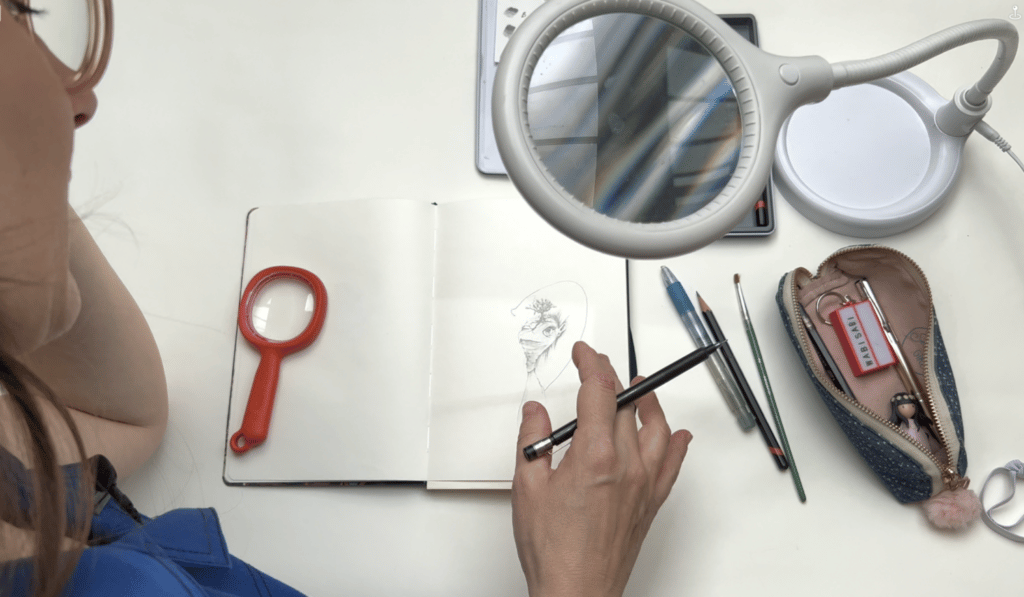
Karen Maenhout in her studio in Antwerp. (Photo: Hélène Mulder)
What made you the artist you are today?
On the one hand you can say: education. Apart from a master’s degree in graphic and advertising design at the Academy and a teaching degree, I also completed several other creative trainings. But those are just diplomas. Those alone are not the things that make me the artist I am today. Living and experiencing life is far more important to my work. For me, being able to speak through my work, has become a way of moving through life.
Why are emotions so important to you?
I’ve learned to accept them. I’m a high-sensitive person. Everything moves inside of me in a very intense way. Not only emotions or feelings, but also smells, sounds, touches. Now I know that. Without letting myself get too carried away by it, I can later retrieve that feeling or intensity and channel it into a drawing. But it used to upset me, which always resulted in a struggle. Now I accept it as something positive from which I can benefit greatly. It is a strength. It is both a pitfall and a blessing.
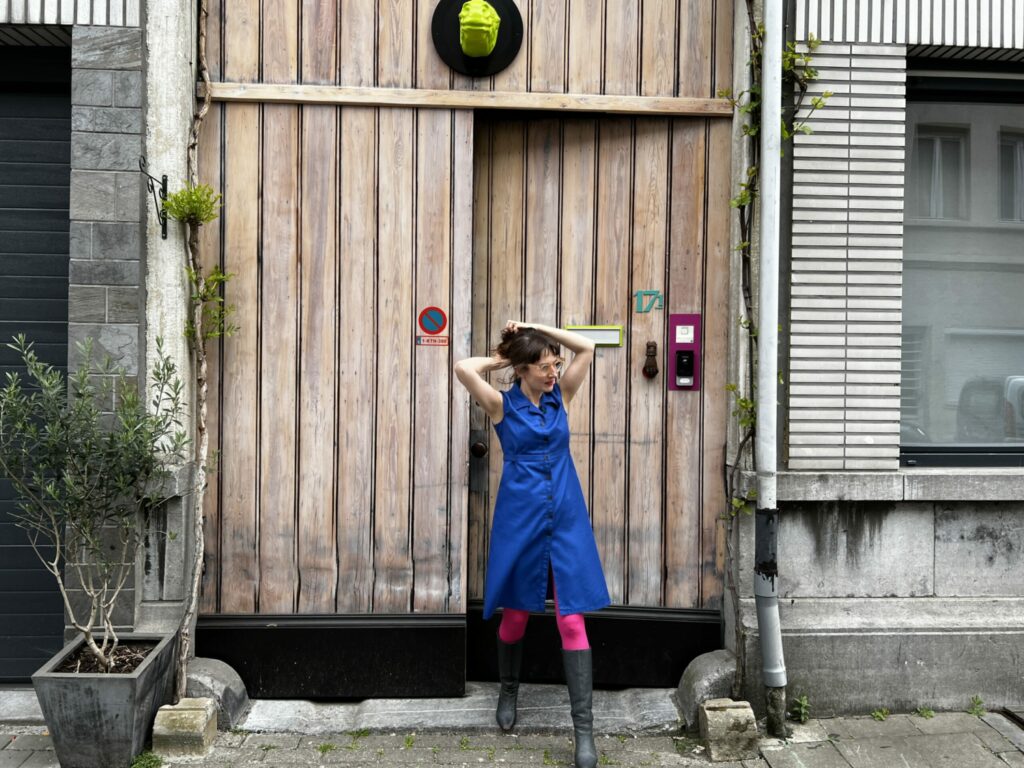
Karen Maenhout in front of her studio. Karen in her atelier with her dog Kiwi. (Photo: Hélène Mulder)
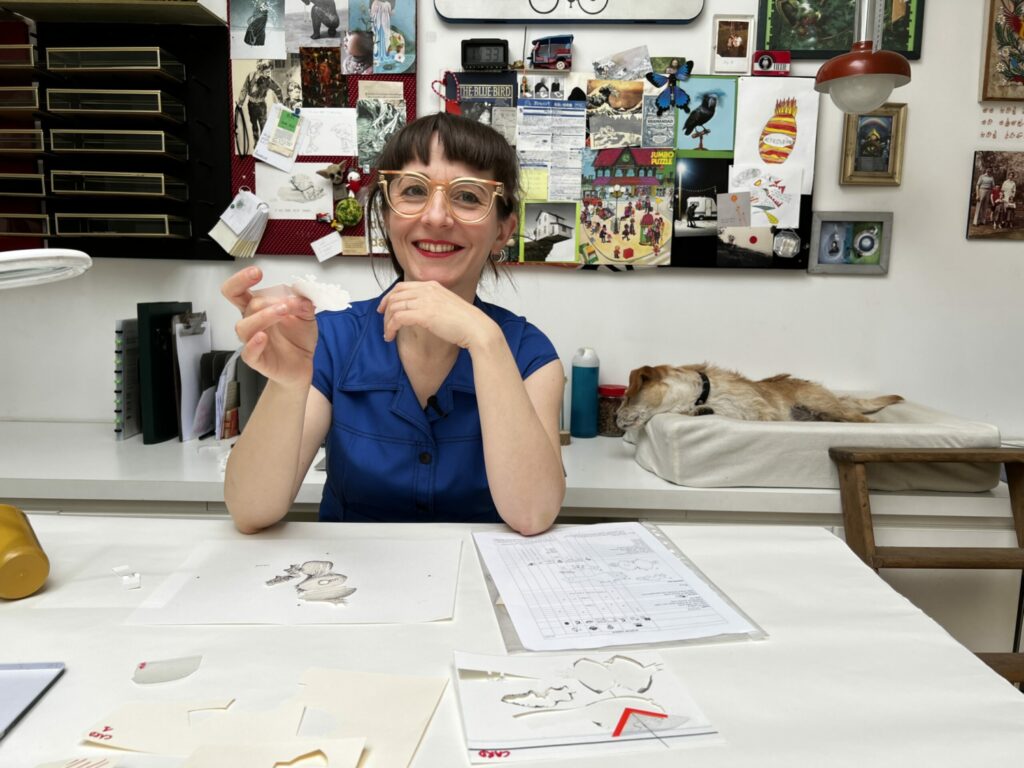
What can you attain with the use of emotions?
Comfort and connection. People want to be seen and recognised. When you have the feeling that nobody understands you, recognition can be very comforting. When a drawing is finished, I consciously choose not to say what it’s about. It can mean different things, evoke different feelings for everyone. Everyone reads it in a slightly different way, based on experiences.
If you want to accomplish something with emotions, first of all, people need to open up. Not everyone welcomes emotions. You have to want it. It’s the same with being honest, that’s a choice. Either you hide behind masks, or you expose yourself with the chance that you’ll be spoken to.
What is the greatest compliment?
The greatest compliment is when one cannot find words. That the drawing touches them in a certain way that they feel heard. It’s good to give people time to experience the drawings.
It does something special with me when someone shares a very intimate story, and then asks if I can transform that into a drawing without turning it into a comic strip. That you symbolise a struggle or a quest?
Can you guide us through your intuitive process of drawing?
There are clients who give me carte blanche, who give me the freedom to visualise their story through my expression, and there are clients who have certain visual expectations. The latter group are the most difficult, because that is precisely what I do not do. How can you convince them that surrendering gives a much more powerful result than imposing restrictions? I draw intuitively, on a feeling, not on a specific result.
The clients who give me complete freedom, get the best results, because then – while drawing – I can really let things come to me and reflect their story best. Then I don’t think about: “What do they expect from me?” or “Will they like this?” Because they give you full trust. They are really curious about my expression and look forward to the result.
I read my notes about their story and can totally feel what they have been through. I feel the sadness, a bad connection with a child, the loss of a parent, a very sudden blow. I feel that. And that is the right time to start drawing.
I tune in to a feeling.
Then I hold my pencil in my hand and I start to turn it. I let myself be inspired by the curls or the vague lines that emerged. For a moment I look at them and wait. It’s a challenge not to say: “Ah no, that’s not a good one, we’ll take the next page.” I really want to use that. I also erase very late. When I draw something and think “that’s not it, it doesn’t want to be, it’s not right”, only then I erase it.
I’m aware that originality does not exist. Parts of the things I draw, I must have seen somewhere. A piece of a branch in which I could see exactly one hairline. Or is that a piece of stone? You “steal” and you use it into your drawing. Sometimes you actually notice that the drawing says: “Hey, I don’t want to be like that, that’s not me, you have to erase it.” And only then do I find it OK to erase. On a rare occasion, it happens that I end up with a drawing that I really don’t like. So I stop, but later I try working on top of it, giving it another layer. Because I strive to take that drawing back and make something new out of it. I see that as: “It’s just not finished yet, and now I’m not feeling it”. I used to have trouble finishing a drawing, but by drawing with feeling, I really feel: it’s been told.

Pop-up “Your” as part of an edition, handmade by Karen Maenhout (Photo: Hélène Mulder)
As a paper engineer you bring flat paper to a 3D volume of paper, a pop-up. What is the magic of a pop-up?
A pop-up is a 3D paper shape that allows itself to be unfolded from a closed page to an open page.
It is better to ask: what is the magic of a good pop-up? You have pop-ups that are just folded into a book and when you open it, they pop up. If it only does that, it’s not successful for me. The mechanism, that’s not where the magic is.
A good pop-up has to add value to the story. Make the feeling more intense. Because of the 3D element, the pop-up brings that feeling just a little closer. Only then, it brings the emotion closer and truly conveys it. That’s when the magic happens.
I start from a drawing and research the movement of the pop-up. The pop-up is something mathematical because it has to fold correct when the book is closed again. But I look for ways to convey the feeling. When you open it – and the idea is to open it slowly – how does it come out? How is the movement of the pop-up? The pop-up must be inferior to the intention, it must contribute to what the work has to say and only then do I consider it successful.
Pop-ups for children’s books have a different purpose, you can pull and move them all you want, but a pull-tab would not work for me. People shouldn’t look at the drawing questioningly and say: should I pull this? No, they should be like: Oohhhhh… yes (silent) (laughs)!!!
What makes you different from other illustrators?
I don’t tell stories, I offer drawings that people can read. And when they are read, then they are stories.
I’m an illustrator and paper engineer but what I mainly do is convert a feeling or experience into a drawing. If you experience a feeling when you look at my work, then I’ve succeeded.
“What makes me different from other illustrators is: when I feel sincerity from the person telling it, whatever the assignment might be, then I will be able to tune in and turn that feeling into a drawing.”
When people open up to me, I sense that so deeply. It feels as if I’ve experienced it myself. I can even recall that feeling afterwards and use it in the drawing. I believe that is my quality. I implement it in everything, I translate what I’ve heard into all the elements. From the blackness of my pencil, the grain and thickness of the paper, the colour of the bamboo to the slow movement of turning the pages. It’s in every detail. And that turns it into a total experience of delivering a story.

Drawing “Original” and pop-up “And beyond” by Karen Maenhout (Photo: Hélène Mulder)

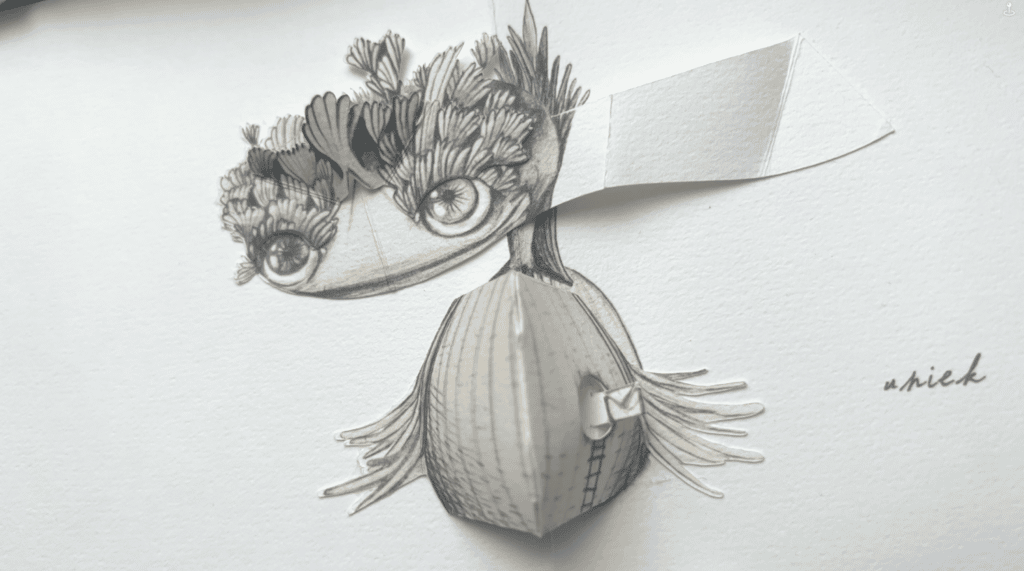
Pop-up’s by Karen Maenhout (Photo: Hélène Mulder)
What does the name of your brand, Smallstories, mean?
The longer I work with it professionally, the more I feel the name Smallstories is well chosen. It captures so perfectly what I do. It is not a small story, it is a big thing what people share. But usually the essence is in the small things. In my drawings, stories can be read in the small details. The symbolism and the elements in the drawings are all small stories, very changeable but very important.
I think that is the added value of SmallStories. I try to tell people not to get hung up on it, next week it will be different again. The drawings can evoke something, especially the ones I create in commission. Every time there is an element that jumps out, depending on how you feel that particular moment. One moment you see those three little lines that sparkle and give light and hope, another time it’s the heaviness or darkness that takes over in the same drawing. The changeable that grows along with it are also small stories. You just have to allow it to happen and look at the work differently.
What gets you out of your comfort zone?
Dishonesty, I sense that.
And it’s a dangerous thing for me. Because sometimes you don’t know the reason for that dishonesty. When I’m with people who are dishonest, my trap is to take it personally when it could be a million other things: they don’t feel comfortable in a big group or they’ve just experienced something personal that they don’t want to talk about… But I do sense that, I feel that something is not open.
That’s also the reason why I do not watch the news, but only follow it on the radio. It is the power of negativity that is too strong for me. Why not put a light on different aspects of life instead of only the negative? You might as well give a view of the world with both the negative and the positive reports, that gives a better perspective. I know the negative is always better remembered and retained than the positive. People were always better off thinking that bad was better than good. Was it not those who attributed the rustling of the bushes to a lion and not to the wind, who were able to tell others of?
What is your big wish for the near future?
That I can reach the people who benefit from my work, who are affected by it. That they discover it. That I really reach the people I am doing it for. And a little more comfort and peace for myself, perhaps? No, maybe not, maybe then I might not be able to draw like this any more…
Karen’s recommendations:
- Fred & Ferry Gallery, Antwerp
- Cut & Fold Techniques for Pop-Up Designs, Paul Jackson, Laurence King Publishing
- Where the Crawdads Sing, Delia Owens, The House of Books
- Newsletter by James Clear
- Visit Japan or Swiss Bohemia, the Czech Republic
Other creators in their chambers:
JonCha, hatmaker Agave Road Hats
JonCha Agave Road HatsJonCha, short for Jean-Charles, is a French multidisciplinary artist, operating in the world of theater and storytelling. He works as a composer, director, actor and...
Elena Lin: performer, teacher and visual artist
Elena Lin is a renowned choreographer, performer, martial arts practitioner, art therapist, visual artist and instructor. She has developed a highly regarded international reputation for her unique educational programme “House of five elements”, which is designed for contemporary dancers and performing artists.
Deborah Kiwi, conceptual shoedesigner and maker
With professional designing skills already in her hands, award-winning Deborah Kiwi immersed herself in the classical, artisan methodology of shoemaking and the less conventional path of conceptual...
visibility for creators
Creators Chambers offers creators an extra channel to enhance their online visibility. For help improving your online presence, send Hélène Mulder a message.

